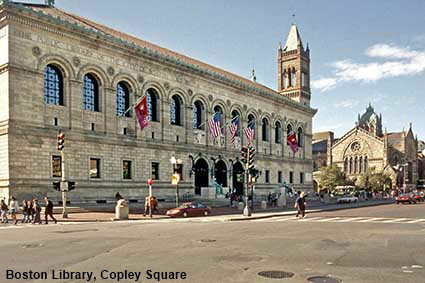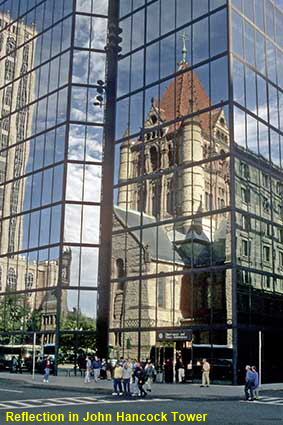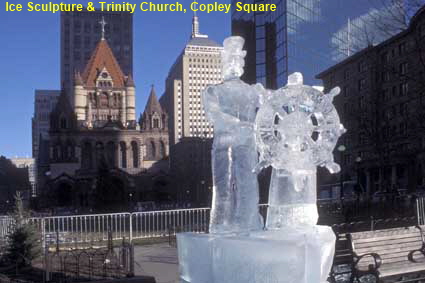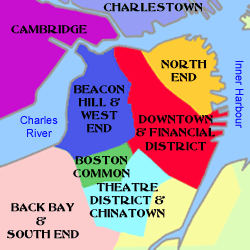Ice Sculpture & Trinity Church, Copley Square
The residents of the elegant new houses constructed in Back Bay required and elegant new church and in 1877 they got one. Trinity Church was designed by Henry Hobson Richardson and it is considered to be one of the finest churches in the USA. It replaced a church on a different site that burned down in the 1872 Great Boston Fire. In the foreground of the picture is an ice sculpture on show as part of Boston’s New Year celebrations
Back Bay & South End
Reflection of Trinity Church in windows of John Hancock Tower
New England’s tallest building at 241 metres (790 feet) high has a rather chequered history. Designed by I.M. Pei and Henry N. Cobb, the John Hancock Tower was completed in 1976. During construction the retaining walls for the excavations warped, causing damage to nearby services and buildings including Holy Trinity Church. As work was nearing completion, window panes began to fall from the building in moderate winds. A design defect was identified and all of the panes had to be replaced. Once opened it was found that the building swayed in the wind to the extent that occupants of higher floors suffered from nausea. Dampers were added and the building was strengthened to eliminate a possible risk of the building being blown over in extreme winds.
Boston Library, Copley Square
In 1848 the first metropolitan public library in the USA was established in Boston. The library soon grew too big for its building, so plans were laid for a new library building in the newly reclaimed Back Bay area. Standing on Copley Square, named after American portrait painter John Singleton Copley, the Boston Public Library was built between 1887 and 1895. Styled along the lines of an Italian Palazzo, the building was designed by architect Charles McKim. In the 20th century the library once again outgrew its premises, so in 1971 it was split between the McKim building and a new building designed by Philip Johnson in Boylston Street.
DLU090804
Click on Minimap to navigate
Home > US States > New England > Massachusetts > Boston >
How can a district in Boston be called a bay? Because once upon a time it really was a bay. The peninsula on which early Boston stood had a very narrow neck courtesy of the tidal Back Bay. In the middle of the 19th century work began to fill in Back Bay and by the 1880’s houses were springing up where once there had been tidal mud flats. The South End of the old peninsula with its English-style town houses suddenly found that it had an elegant neighbour planned along French lines with wide boulevards.





To move forwards or backwards through the Boston trail click the arrows above, or select your next destination on the Minimap.


© Mike Elsden 1981 - 2025
The contents of this page may not be reproduced in full or in part without permission